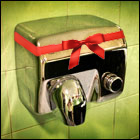|
Harik posted:No, I make 75k but have 6 kids and 6 thousand dollars of tax credits wipes out what I owe. Check for low income programs, you're 150% < X < 200% the federal poverty guideline and programs generally base themselves on some % of that number. I don't mean this as a dig, I hope you get some free money out of it. https://familiesusa.org/product/federal-poverty-guidelines Net metering is always better (or I would have a hard time coming up with a way for it not to be better. Net metering they effectively pay you retail distribution + retail power, wholesale buy they pay you $0 distribution + wholesale power.) You want it if it's available. What I may have left out is to make sure how they meter these things. If they buy your generation separate from your consumption it's not as good of a deal as you think in your head. I don't know what the terms are, but think of it this way for Net Metering: You generated 100kWh and used 78kWh, you get a credit towards future bills of 28kWh and a $0 bill. You might even get a refund at the end of the year, who knows. Net Wholesale: They buy your net generation for 10 hours that day of 60kWh (78kwh per day / 24 = 3.25, I rounded up to 4) for $0.08/kwh = $4.80 credit. They sell you the remainder of 38kWh for $0.20 = $7.60. You get a bill for $2.80. Whole Buy, Retail Sell: They buy your 100kWh for $0.08/kwh = $8.00. They sell you your 78kwh for $0.20 = $15. You get a bill for that day of $7.62. That's a big difference in little details. This doesn't include things like you use a lot more power during the day than at night in all likelihood.
|
|
|
|

|
| # ? Jun 3, 2024 12:25 |
|
That Works posted:Anyone have any experience with / recommendations on fireplace inserts? We got a wood burning insert and it was just nice to move to a closed system that can burn unattended ó no need to wait for the fire to die to go to sleep. Cost was around $3500.
|
|
|
|
~Coxy posted:See if you can find anyone on pvoutput near you. That gives you real-world figures on how many units you can expect to generate based on a certain size system. At least I know the electrical numbers, that helps with one end of the equation. H110Hawk posted:Check for low income programs, you're 150% < X < 200% the federal poverty guideline and programs generally base themselves on some % of that number. I don't mean this as a dig, I hope you get some free money out of it. https://familiesusa.org/product/federal-poverty-guidelines Agreed! I think my power company supports net and I'll look into it. I'll also look into those programs, I didn't think I qualified but 200% FPL is a thing.
|
|
|
|
Anybody have resources for kitchen lighting design/best practices / lessons learned? Turns out when we said "put the skylight where the crappy overhead fixture is", that's exactly what happened and now I need kitchen lighting design.
|
|
|
|
Niacin posted:Anybody have resources for kitchen lighting design/best practices / lessons learned? The biggest thing I pay attention to in kitchen lights is making sure task areas/surfaces are lit without shadows. In most kitchens this is overwhelmingly handled by under cabinet lighting (led strips are awesome). If you have an island it's lighting over that. The rest is simply preference.
|
|
|
|
Motronic posted:The biggest thing I pay attention to in kitchen lights is making sure task areas/surfaces are lit without shadows. In most kitchens this is overwhelmingly handled by under cabinet lighting (led strips are awesome). Agreed. When the previous owners redid the kitchen before I bought it, they did an excellent job with this. There are (on separate switches): -10 can lights around the perimeter (on a dimmer) -2 separate cans on a switch above the sink -7 under cabinet lights hardwired (5W leds each) -1 fan/light fixture near the stove -1 chandelier light over the kitchenette area -standard light/fan over stove Turning them all on at once would be ridiculous, but it's nice to be able to put the light right where you need it where you're working. As ambient light, we just leave either the 2 over the sink or the cabinet lights on, which is subdued, but plenty to see without using too much energy. In short, put in more lights on separate (dimmer ideally) switches than you think is reasonable. Nobody ever says my kitchen, laundry room, garage, or basement has *too* much light.
|
|
|
|
B-Nasty posted:Turning them all on at once would be ridiculous, but it's nice to be able to put the light right where you need it where you're working. As ambient light, we just leave either the 2 over the sink or the cabinet lights on, which is subdued, but plenty to see without using too much energy. This is a really good point. The only time I have everything on is when we're entertaining. The only down side is I have to make a run around my kitchen every night to turn off all the lights with switches in appropriate places for the task lights to get everything shut down. It's on my home automation nerd list to put in z wave switches so I have a "f this I'm going to bed" button that just turns off everything downstairs.
|
|
|
|
That Works posted:Anyone have any experience with / recommendations on fireplace inserts? I had a lopi freedom installed with the flush mount. It was about $4500 which included lining/sweeping the chimney. Works great, between that and adding a heat pump it cut our propane usage down to 200 gallons a year. It keeps most of the house at 70+ degrees.
|
|
|
|
So I want to get some under cabinet LED lights for my rental because there is absoutly no over head task lighting and its pretty anoying. I was looking at this kit: https://www.amazon.com/Albrillo-Cabinet-Lighting-Dimmable-Counter/dp/B06Y46JKL6/ Any other opinions or thoughts? Maybe someone else has used one that they like and is easy to install?
|
|
|
|
I need under cabinet lighting too... was thinking about Ikea. I need mine to plug into a wall outlet. Would be pretty cool if i could wire a low voltage switch for the whole thing to the outside of one of my cabinets.
|
|
|
KKKLIP ART posted:So I want to get some under cabinet LED lights for my rental because there is absoutly no over head task lighting and its pretty anoying. I was looking at this kit: I used the same brand for the kitchen in our new house. Only difference is I used the "warmer" 3000k version instead of the bright white 5-6000k one you linked. https://www.amazon.com/gp/product/B01ARQY31S/ref=ppx_yo_dt_b_asin_title_o09__o00_s00?ie=UTF8&psc=1 This is a pic I just took. This is the ones setup in our kitchen with no other lights on. It's 8:30am and overcast grey outside so it's pretty dim in the kitchen otherwise.  I quite like ours and we just leave them on constantly as sort of the only light downstairs that stays on. Installation of the LEDs themselves was quite easy, the cable hangers that come with the kit did not stick or adhere the cable well, but there are dozens of ways to solve that problem. I'd recommend them for sure. They helped the kitchen a lot. The little bulb under the microwave was the only thing illuminating the stovetop initially and it was just awful really.
|
|
|
|
|
That Works posted:I used the same brand for the kitchen in our new house. Only difference is I used the "warmer" 3000k version instead of the bright white 5-6000k one you linked. Good to know. I always heard you wanted more white light for food but I think it would stand out s whole lot. Iíll have to think about that.
|
|
|
KKKLIP ART posted:Good to know. I always heard you wanted more white light for food but I think it would stand out s whole lot. Iíll have to think about that. We had some 5000k white lights in our previous kitchen and neither my spouse or I liked the way it made the room feel. Honestly most of the house is in 3000k LED now and it fits a lot better with everything (to us). This is probably just a personal preference thing.
|
|
|
|
|
That Works posted:We had some 5000k white lights in our previous kitchen and neither my spouse or I liked the way it made the room feel. Honestly most of the house is in 3000k LED now and it fits a lot better with everything (to us). This is probably just a personal preference thing. Awesome. I'll probably just stick with the 3000k lights then, all the rest of our lights are that temp. Excited to actually have some light over my food prep area instead of a bunch of shadows.
|
|
|
|
I fiddled around a lot with (CFL) bulbs and temperatures when I got my house and 5000K bulbs are definitely too blue for a kitchen IMO, but I also thought 3000K bulbs were a bit too warm. You might consider something around the 4000K temp.
|
|
|
|
Most commercial buildings will use 4100K in work areas like shops and kitchens or parking garages; 5000 is just too super blue for most places even in a commercial setting. A rule of thumb from my commercial experience is 2700 for bathrooms or places you want people to look most favorable at the expense of detail and color, 3000 for offices and places where people spend most time, 3500 for hallways and common areas, 4100 for back-of-house and mechanical areas. I think a simplified version translates well to my house where I mostly use 2700 or 3000 except in my basement shop and the garage where 4100 is good for me.
|
|
|
glynnenstein posted:I mostly use 2700 or 3000 except in my basement shop and the garage where 4100 is good for me. This is exactly how we have ours setup. Just ran a bunch of overhead 4000k LED in the basement wood shop.
|
|
|
|
|
glynnenstein posted:2700 for bathrooms or places you want people to look most favorable at the expense of detail and color I couldn't put warm bulbs in my bathroom because I painted my walls a nice green but the warm bulbs made it look sickly and a bit pea soup. Not ideal. Put in 5000K was also awful. Ended up with 4000Kish bulbs. Boy, that was an adventure.
|
|
|
|
If you have any type of voice assistant (Google home/Alexa) think about connecting your lights with a compatible smart plug. Being able to turn on your counter lights by voice when cooking sure is convenient. Personally, I use RGBW strip lights in aluminum tracks with diffusers and a Fibaro RGBW controller. (https://smile.amazon.com/Fibaro-Micro-Controller-Z-wave-Strips/dp/B00P1N68FW) If you run Home Assistant, it supports the MiLight wifi controllers which are a lot less expensive but can't provide/report their current state (on/off/color/dim level stuff). And an idea for night lites in the kitchen--if you have unused space between the top of your cabinets and the ceiling, put some RGB(W) strip lights up there on a dusk to dawn outlet. (https://www.lowes.com/pd/PRIME-15-Amp-2-Outlet-Mechanical-Residential-Plug-in-Countdown-Lighting-Timer/4740852)
|
|
|
|
Apologies if this is a really dumb question: I'm currently planning out a new deck for my house, and when I went to the local town hall to ask about permitting, they handed me a packet for deck building standards (basically a visualized code packet for dummy homeowners so they don't make death-trap decks that kill half the guests at the next house party because we live in a nanny state and I'm not allowed to kill my guests anymore Since this is baby's first foray into real framing, I've been learning the joys of penny weights and so forth, but when I look up 10d common nails I see that they specify 3" x .148" diameter nails. As I'm not a masochist, I want to use a framing nail gun, but the only collated plastic nails I can find that are close enough are 3" x .131" ring-shanks. What I've read online is that adding an extra nail can suffice to give the smaller collated nails the same shear strength (so, for example, if they ask for 3 10d nails on a rim joist, throw an extra nail in there to compensate). Can anyone familiar with code comment if this is a good idea, or should I be trying something completely different? I really don't want to go with 3 1/4" nails because that's going to be hell trying to keep nails from popping out the other side of the joists, but if that's the best way to do it, so be it. Also, anyone have any experience with the Camo decking fastening kits? I'd really like to try hiding the screws but I'm torn between using something slick like that vs. going for some bog-standard decking screws. Any advice is appreciated!
|
|
|
|
I'm wiring some 220v outlets for my wood shop, and one of the items is a dust collector. The DC will be in another room (for noise and dust reduction) and I'd like to turn it on remotely but all the options seem either complex, or really expensive. Would there be an issue just wiring a typical switch, like a light switch, to the line? All my saws will be in the same area so I don't mind flicking a wall switch. It still beats going to another room to turn the DC on each time. I assume I'd need a 220 capable switch, but I'm not having good results on Google finding if that's even a thing. Any ideas/advice?
|
|
|
|
I doubt you'll find a 220 light switch, but yes there should be plenty of generic switches you could mount on the wall vvvv well lookie there, that's why I never post in these threads haha
|
|
|
|
You're looking for a double pole toggle switch: https://www.homedepot.com/p/Leviton-20-Amp-Commercial-Double-Pole-Toggle-Switch-White-R52-0CSB2-2WS/202027029 Make sure it's appropriately rated for your load.
|
|
|
|
keep it down up there! posted:I'm wiring some 220v outlets for my wood shop, and one of the items is a dust collector. The DC will be in another room (for noise and dust reduction) and I'd like to turn it on remotely but all the options seem either complex, or really expensive. Could you use a breaker of some sort? My car charger is 240/80 and has a shut off switch inline, but I donít know how much that part cost. (Itís covered in snow right now or Iíd take a picture.)
|
|
|
|
keep it down up there! posted:I'm wiring some 220v outlets for my wood shop, and one of the items is a dust collector. The DC will be in another room (for noise and dust reduction) and I'd like to turn it on remotely but all the options seem either complex, or really expensive. I can't give you any specifics since I don't trust myself with high power electrics, but I can't imagine that there would be such a thing as switches that differ between 120v and 220v, instead I'd expect them to be rated for a specific wattage, perhaps written as a combination of voltage and amperage (since wattage is volts * amps). If you don't want to look around for switches designed for isolating workshop equipment then it might be worth looking at switches designed for isolating cookers. For example I have something that looks like this for my cooker line which is rated for something like 62A at 240V: 
|
|
|
|
Motronic posted:You're looking for a double pole toggle switch: https://www.homedepot.com/p/Leviton-20-Amp-Commercial-Double-Pole-Toggle-Switch-White-R52-0CSB2-2WS/202027029 Perfect! Thank you! It's amazing what just knowing the proper term does. I searched every iteration of "220 switch" I could think of with no results. Double Pole Toggle gets me tons of info. keep it down up there! fucked around with this message at 20:25 on Feb 19, 2019 |
|
|
|
Ripoff posted:Since this is baby's first foray into real framing, I've been learning the joys of penny weights and so forth, but when I look up 10d common nails I see that they specify 3" x .148" diameter nails. As I'm not a masochist, I want to use a framing nail gun, but the only collated plastic nails I can find that are close enough are 3" x .131" ring-shanks. I could be off base -- hard to tell from your post -- but they may be referencing using specific joist-hanger nails like these: https://www.homedepot.com/p/Simpson-Strong-Tie-10d-x-1-1-2-in-Ring-Shank-Stainless-Steel-Connector-Nails-1-Lb-SSNA10D/206516593 For the hangers, you have to use these Simpson nails or the equivalent Simpson screws, because they are specifically engineered to have the sheer and pullout strength required. Regular ol framing nails (or worse, roofing nails) are not rated for this use. I had to replace the roofing nails used by some dummy in my porch's joist hangers.
|
|
|
|
B-Nasty posted:I could be off base -- hard to tell from your post -- but they may be referencing using specific joist-hanger nails like these: https://www.homedepot.com/p/Simpson-Strong-Tie-10d-x-1-1-2-in-Ring-Shank-Stainless-Steel-Connector-Nails-1-Lb-SSNA10D/206516593 Sorry for the confusing post. Yes, I will need to use those joist-hanger nails for hurricane clips to attach the beams and joists, as I'm required by the local code to make a free-standing deck since I have a brick veneer house. As it's a freestanding deck, I'm also required to dig a hole for the cement footing that is the same depth of the house's footing (since the first post is less than 5 feet from my house) and, since I live on a hill with a partially exposed basement, I get to dig an 18 inch wide, 6 foot deep hole for my first footing, then fill that fucker with a 12" stem from there.  As for their building requirements, I was able to find a digital link (warning: horribly scanned PDF ahead) and they're asking for the 10d nails for the blocking between joists (as well as the rim joist):  I've been through the document and they don't seem to really want to define what the 10d nails are supposed to be aside from ring shanked or annular grooved. Nothing about common, box, etc. which is kind of odd considering how they call out very specific zinc coating requirements for hardware on the deck. funeral home DJ fucked around with this message at 02:38 on Feb 20, 2019 |
|
|
|
My wife and I both like the idea of adding a front porch (full length) to our house, and we are soon possibly going to have the opportunity to do so. (Some other construction projects might make it feasible.) But I'm concerned that a covered porch will prevent some sunshine from getting into our already too-dark house. The front of the house is south-facing. The rear windows don't usually let much direct light in, and there are almost no windows on the sides (east/west). I should also definitely mention the fact that there are lots of trees around our house, which could certainly be the actual problem. Still, obviously sunlight gets in -- but the most comes in through the front windows. Our ceilings are about 8 feet high, and I imagine the ceiling of the porch would be about the same. (2-story house, if that matters.) It would probably be 5 feet deep, though we're considering up to 10. I can only assume more depth = less light, so that will weigh heavily on this decision. We've considered the possibility of a pergola top instead, with some kind of transparent or retractable top, but reached the conclusion that it would look like garbage. (We still plan something like that for the rear deck, just not the front.) So basically my question is, where do my concerns rank on a scale of "totally unfounded" to "correct, but there's nothing you can do about it aside from not adding a covered porch"? Do covered porches tend to make any significant difference in how much light gets in the house? Sir Lemming fucked around with this message at 18:38 on Mar 1, 2019 |
|
|
|
You'll have to excuse my ignorance coming from a maritime climate but isn't one of the main purposes of a covered porch to prevent lots of sunlight getting into the house, being that's why they're used so often in hot climates like Australia?
|
|
|
|
The angle of the sun is obviously important, so you have some play with the sunlight by adjusting the depth of the porch and the height of the roof.
|
|
|
|
Jaded Burnout posted:You'll have to excuse my ignorance coming from a maritime climate but isn't one of the main purposes of a covered porch to prevent lots of sunlight getting into the house, being that's why they're used so often in hot climates like Australia? I guess that's a strong possibility, since they're pretty popular in the South. We're more interested in just having a nice place to sit outside and stuff like that (and still being able to do that when it's raining).
|
|
|
|
Sir Lemming posted:I guess that's a strong possibility, since they're pretty popular in the South. We're more interested in just having a nice place to sit outside and stuff like that (and still being able to do that when it's raining). Perhaps then the solution is a non-opaque material. You've mentioned concerns about a transparent material looking naff and I can definitely share that worry, but there's no doubt something that would work out, perhaps a high quality transparent material, or something translucent, or maybe a white waterproof fabric-like material where the light would diffuse through it rather than stop dead. That and also measuring your angles etc as mentioned above. Perhaps you could get some large sheets of something cheap like plywood or cardboard or an opaque fabric and mock up a roof, see how it affects your light.
|
|
|
|
How about a gazebo somewhere else in the yard?
|
|
|
|
Carport-ish covered decks (terraces) with clear plastic roofs are common here. https://www.ex-shop.net/index.php?action=public_item_tr_estimate_input&item_id=7779 You could also consider adding or enlarging your windows.
|
|
|
|
Iím moving into a house with 100+ year old heart pine floors. They seem in pretty good shape and Iíd like to avoid refinishing if I can. Two questions: Anyone have any experience with wood floor Ďrejuvenateí type products? Are they worth it/do they actually do anything? Can anyone recommend a motorized non-commercial floor polisher/cleaner? My microfiber mop is fine for cleaning but Iíd like to have the floors look nice when Iím done.
|
|
|
|
I have a really crappy gate into my front yard, itís wide and heavy and sags no matter what I do. Iíd like to replace and upgrade it, possibly by putting in a couple of brick pillars (that match the brick on our house) with a lighter gate in between. Is brickwork fairly easy to DIY with no experience? I have done some light tiling and concrete work but never bricks.
|
|
|
|
TheManWithNoName posted:I have a really crappy gate into my front yard, itís wide and heavy and sags no matter what I do. Iíd like to replace and upgrade it, possibly by putting in a couple of brick pillars (that match the brick on our house) with a lighter gate in between. Is brickwork fairly easy to DIY with no experience? I have done some light tiling and concrete work but never bricks. Thereís nothing like incredibly difficult about it, but I wouldnít make my first job the first thing everyone sees when they come to my house either. At least one of them is probably going to look fugly. The 2nd might be better.
|
|
|
|
If you're trying to save on money for skilled jobs I've found a good way is to do a lot of the prep on a job; buying and positioning materials, clearing the area, doing as much unskilled labour as possible, then bringing in someone to do the skilled part. So in this case something like clearing the existing gate, digging (and possibly pouring) a foundation if needed, buying bricks and getting them in position nearby, same for cement and sand or whatever ingredients your brickie wants, and getting power and water available. Then they just have to show up, mix it, lay it, and go. I've found trades to be much more accommodating then because they're not doing the boring poo poo and they charge by time anyway. If you're doing it to learn the skill then be prepared for it to take 4 times as long and to have to do it twice to get a good finish; that's the cost of learning it. Jaded Burnout fucked around with this message at 19:56 on Mar 3, 2019 |
|
|
|

|
| # ? Jun 3, 2024 12:25 |
|
Bought a $30 LED light kit and installed it above the workbench, itís actually usable now. Next step is to revamp the garage lighting with LEDs and add another light above the workbench area. 
|
|
|






































 i like nice words
i like nice words






